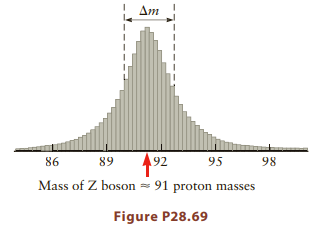In 1983, a hypothesized heavy force-carrying particle called the Z boson was discovered by studying the collisions
Question:
In 1983, a hypothesized heavy force-carrying particle called the Z boson was discovered by studying the collisions of protons at the European Particle Physics laboratory, CERN. Just as a photon transmits the electromagnetic force, the Z boson carries the weak nuclear force (Section 31.5). Consider an experiment in which many Z bosons are produced, and the mass of each can be calculated by looking at the kinetic energies and trajectories of the particles into which it decays. The mass of each Z boson is then plotted in a histogram like that in Figure P28.69, which gives an average value of approximately 91 proton masses! We find that the actual mass of the particle can be quite different from one Z particle to another, and no matter how great the precision of the measurement, the distribution of the mass is spread out with an uncertainty of about 2.5 proton masses. What is the approximate lifetime of this particle? Consider the mass–energy relationship from Chapter 27. How is the lifetime of a particle (i.e., its decay time) related to the uncertainty in the particle’s mass?

Step by Step Answer:

College Physics Reasoning and Relationships
ISBN: 978-0840058195
2nd edition
Authors: Nicholas Giordano





